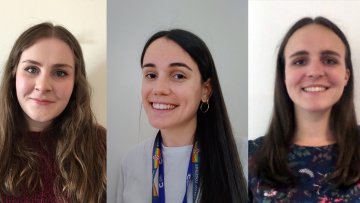Approximating Persistent Homology for Large Datasets
Abstract
Persistent homology is an important methodology from topological data analysis which adapts theory from algebraic topology to data settings and has been successfully implemented in many applications. It produces a statistical summary in the form of a persistence diagram, which captures the shape and size of the data. Despite its widespread use, persistent homology is simply impossible to implement when a dataset is very large. In this talk, I will address the problem of finding a representative persistence diagram for prohibitively large datasets. We adapt the classical statistical method of bootstrapping, namely, drawing and studying smaller multiple subsamples from the large dataset. We show that the mean of the persistence diagrams of subsamples—taken as a mean persistence measure computed from the subsamples—is a valid approximation of the true persistent homology of the larger dataset. We give the rate of convergence of the mean persistence diagram to the true persistence diagram in terms of the number of subsamples and size of each subsample. Given the complex algebraic and geometric nature of persistent homology, we adapt the convexity and stability properties in the space of persistence diagrams together with random set theory to achieve our theoretical results for the general setting of point cloud data. We demonstrate our approach on simulated and real data, including an application of shape clustering on complex large-scale point cloud data.
This is joint work with Yueqi Cao (Imperial College London).
Non-Euclidean Data Analysis (and a lot of questions)
Abstract
The statistical analysis of data which lies in a non-Euclidean space has become increasingly common over the last decade, starting from the point of view of shape analysis, but also being driven by a number of novel application areas. However, while there are a number of interesting avenues this analysis has taken, particularly around positive definite matrix data and data which lies in function spaces, it has increasingly raised more questions than answers. In this talk, I'll introduce some non-Euclidean data from applications in brain imaging and in linguistics, but spend considerable time asking questions, where I hope the interaction of statistics and topological data analysis (understood broadly) could potentially start to bring understanding into the applications themselves.
A model of internal stresses within hydrogel-coated stem cells in transit to the liver
Abstract
In 2020, cirrhosis and other liver diseases were among the top five causes of death for
individuals aged 35-65 in Scotland, England and Wales. At present, the only curative
treatment for end-stage liver disease is through transplant which is unsustainable.
Stem cell therapies could provide an alternative. By encapsulating the stem cells we
can modulate the shear stress imposed on each cell to promote integrin expression
and improve the probability of engraftment. We model an individual, hydrogel-coated
stem cell moving along a fluid-filled channel due to a Stokes flow. The stem cell is
treated as a Newtonian fluid and the coating is treated as a poroelastic material with
finite thickness. In the limit of a stiff coating, a semi-analytical approach is developed
which exploits a decoupling of the fluids and solid problems. This enables the tractions
and pore pressures within the coating to be obtained, which then feed directly into a
purely solid mechanics problem for the coating deformation. We conduct a parametric
study to elucidate how the properties of the coating can be tuned to alter the stress
experienced by the cell.
Extreme eigenvalues of the Jacobi Ensembles
Abstract
The Jacobi Ensembles of random matrices have joint distribution of eigenvalues proportional to the integration measure in the Selberg integral. They can also be realised as the singular values of principal submatrices of random unitaries. In this talk we will review some old and new results concerning the distribution of the largest and smallest eigenvalues.
Magic squares and the symmetric group
Abstract
In 2004, Diaconis and Gamburd computed statistics of secular coefficients in the circular unitary ensemble. They expressed the moments of the secular coefficients in terms of counts of magic squares. Their proof relied on the RSK correspondence. We'll present a combinatorial proof of their result, involving the characteristic map. The combinatorial proof is quite flexible and can handle other statistics as well. We'll connect the result and its proof to old and new questions in number theory, by formulating integer and function field analogues of the result, inspired by the Random Matrix Theory model for L-functions.
Partly based on the arXiv preprint https://arxiv.org/abs/2102.11966
Scaling limits for Hastings-Levitov aggregation with sub-critical parameters
Abstract
We consider, in a framework of iterated random conformal maps, a two-parameteraggregation model of Hastings-Levitov type, in which the size and intensity of new particles are each chosen to vary as a power of the density of harmonic measure. Then we consider a limit
in which the overall intensity of particles become large, while the particles themselves become
small. For a certain `sub-critical' range of parameter values, we can show a law of large numbers and fluctuation central limit theorem. The admissible range of parameters includes an off-lattice version of the Eden model, for which we can show that disk-shaped clusters are stable.
Many open problem remain, not least because the limit PDE does not yet have a satisfactory mathematical theory.This is joint work with Vittoria Silvestri and Amanda Turner.
Congratulations to Oxford Mathematicians Roisin Stephens and Giulia Laura Celora who won prizes for their talks at this year's British Applied Mathematics Colloquium (BAMC) and to Anna Berryman who was a prize winner in the poster category.


